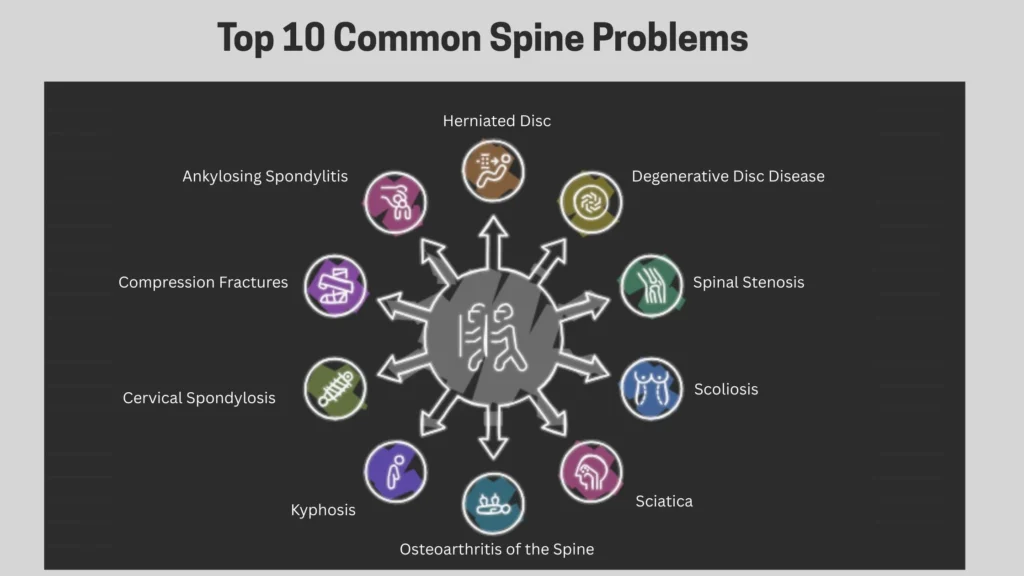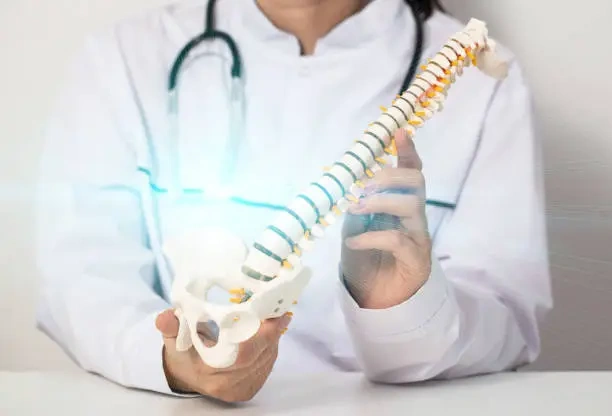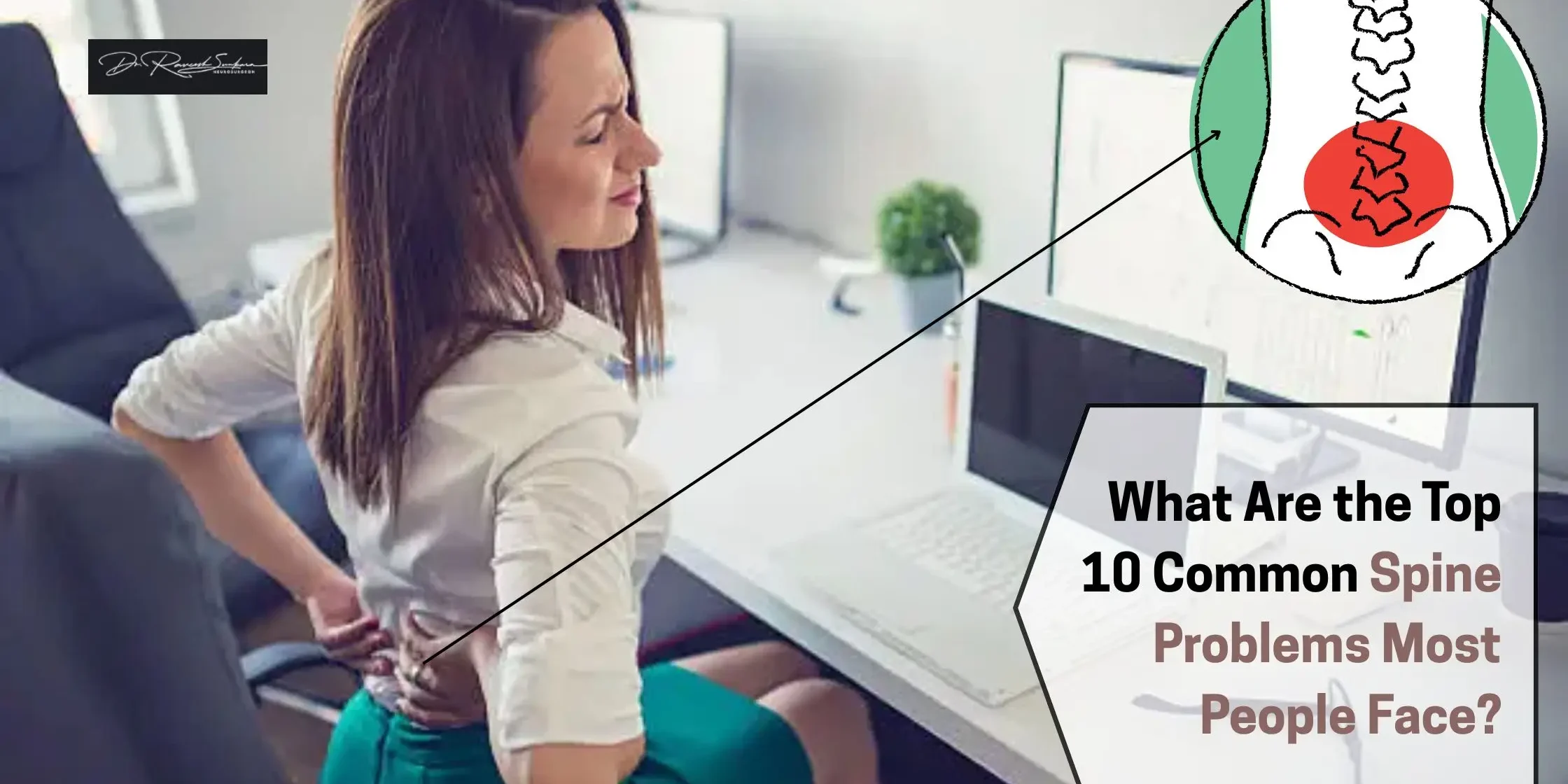A lot of us don’t think about our spine until they hurt. But the truth is that spine problems are one of the main reasons people go to the doctor these days. As the body’s main support system, the spine does more than just hold you up. It protects the spinal cord and makes it possible for you to move.
Did you know? The World Health Organisation (WHO) states that Low back pain (LBP) has the highest prevalence globally among musculoskeletal conditions and is the leading cause of disability worldwide. Spine-related problems can happen to anyone, at any age, whether they work at a desk for long hours or getting older. You can stay flexible, healthy, and pain-free if you know how to spot them early and find ways to fix them.
Key Takeaways
- Lower back pain is the most common reason people can’t work around the world, and anyone of any age can have problems with their spine.
- Herniated discs, degenerative disc disease, spinal stenosis, scoliosis, sciatica, and osteoarthritis are some of the most common problems with the spine.
- Keep an eye out for signs like pain that won’t go away, numbness, weakness, or losing control of your stomach or bowels.
- To avoid getting it, keep your weight in a healthy range, exercise regularly, and don’t lift big things.
- If you see a spine expert early on and get treatment, you can stop long-term damage.
Understanding Common Spine Conditions
Your spine holds your body up, keeps the spinal cord safe, and lets you move. But it’s also prone to damage and wear down. Spine issues can happen because of age, bad posture, or injuries. They could cause long-term disability if not managed.
You can read relevant blogs:
When is Back Pain a Sign of a Serious Spine Condition?
Spine Surgery: When Is It Necessary and What to Expect
5 Essential Tips for a Faster Recovery After Spine Surgery
What Happens After Spine Surgery and Recovery?
Top 10 Common Spine Problems People Face

The most common spinal diseases list and conditions, along with their signs and how to treat them, are mentioned below.
1. Herniated Disc
When the soft part inside a spinal disc pushes out through a tear in its top layer, this is called a herniated disc. Nerves close can get pinched, which can be painful.

- Symptoms: Back pain that comes on slowly or quickly, tingling or numbness in the legs or arms, and muscle loss are all signs.
- Causes: Bad lifting habits, wear and tear from getting older, or an accident.
- Solutions: Rest, painkillers, and spine physiotherapy can all help. In the worst cases, surgery is needed to remove or fix the disc.
2. Degenerative Disc Disease
The discs in your spine become less flexible and less moist as you age, which makes them more likely to get hurt. This is one of the most common spinal diseases.

- Symptoms: Neck or lower back pain that doesn’t go away, stiffness, and pain when sitting or moving.
- Causes: Ageing, repeated strain, or genetic factors.
- Solutions: Regular low-impact exercise, staying at a healthy weight, physiotherapy, and not moving heavy things can help ease the pain. In the later stages, surgery might be thought about. You can also read about “Understanding Spine Degeneration in the Younger Generation”.
3. Spinal Stenosis
When the spinal canal gets too narrow and puts pressure on nerves, this problem happens. People over 50 often have it. Here are some spine disease symptoms with solutions:

- Symptoms: Arms or legs that tingle, feel numb, or are weak, and pain when standing or walking for extended amounts of time.
- Causes: arthritis, tendons that are too thick, bone spurs, or a bulging disc.
- Solutions: Back strengthening exercises, painkillers, steroid shots, and, in the worst cases, surgery are all possible solutions.
Visit here to know about “Spinal Stenosis: Types, Symptoms, Causes, and Treatments”.
4. Scoliosis
Scoliosis is an abnormal curve of the spine that goes from side to side. It is the most common backbone problem often found in kids and teens.
- Symptoms: Shoulders that aren’t level, hips that are tilted, and clear spine curves.
- Causes: Most of the time, no one knows, but birth defects, injuries, or neuromuscular diseases may be to blame.
- Solutions: For minor cases, observation and working out are enough. For kids with mild curves, braces are common. For severe curves, surgery is suggested.
5. Sciatica
This is among the lower back problems in which the pain goes down from the lower back along the sciatic nerve to the legs.

- Symptoms: Pain in the leg that feels like it’s on fire, tingling, numbness, or trouble getting up.
- Causes: The nerve is pressed on by herniated discs, bone spurs, or spinal stenosis.
- Solutions: Rest, spine physiotherapy, anti-inflammatory drugs, and focused stretching are all good ways to help. If the pain lasts for months, surgery may be an option.
6. Osteoarthritis of the Spine
When you have osteoarthritis, the cartilage in your spinal joints breaks down. This makes the joints hurt, feel stiff, and is among the major back pain issues.
- Symptoms: Pain in one area, swelling, a limited range of motion, and stiffness in the morning.
- Reasons: Ageing, injury, being overweight, or a genetic predisposition.
- Solutions: Losing weight, doing low-impact exercises like walking or swimming, and taking painkillers can help lower inflammation. In severe cases, the joint may need to be fixed surgically.
7. Kyphosis
When you have kyphosis, you get an excessive forward curve in the upper back, making your stance round or hunched.
- Symptoms: Back pain, tiredness, trouble standing straight, and, in the worst cases, trouble breathing are all signs.
- Causes: Bad posture, osteoporosis, broken bones in the spine, or problems with a teen’s growth.
- Solutions: Correcting posture, exercise, and bracing for kids are all possible solutions. In severe cases, surgery may be needed to fix the problem.
8. Cervical Spondylosis
Damage to the neck vertebrae and discs that happens with age is one of the cervical spine injury symptoms.

- Other Symptoms: Headaches, shoulder pain, neck pain, and sometimes dizziness.
- Causes: Ageing, bad posture, and using a computer or phone for long periods of time.
- Solutions: Neck movements, painkillers, correcting your posture, and physiotherapy are all possible solutions. Sometimes, surgery is the only option.
9. Compression Fractures
These are small breaks or cracks in the spine that are often caused by osteoporosis. It is one of the top reasons in the spine disorders list.
- Symptoms: Loss of height, sudden, sharp back pain, and spine deformity.
- Causes: Bones that are weak because of osteoporosis, injury, or cancer.
- Solutions: Pain relief, bone-strengthening drugs, physical therapy, and, in the worst cases, surgery to fix the vertebrae or kyphoplasty.
10. Ankylosing Spondylitis
This is a long-lasting inflammatory disease that can make vertebrae join together over time, making it harder to move.
- Symptoms: Lower back pain, stiffness in the morning, tiredness, and, in the worst cases, a forward-stooped posture.
- Causes: Genetics factors and an autoimmune reaction.
- Solutions: Physical therapy, painkillers, learning good posture, and routine exercise can help keep your mobility up.
4 Types of Back Pain You Should Know
Knowing the different kinds of pain can help you get faster treatment:
- Acute Pain that doesn’t last more than six weeks.
- Subacute pain lasts between 6 and 12 weeks.
- Chronic pain lasts for more than 12 weeks.
- Radicular pain is pain that goes from the spine to the limbs.
When to See a Doctor for Spine Issues
Seek help from a doctor if you have the following spine issues. If these problems persist, consulting the best spine specialist in Hyderabad can ensure you receive accurate diagnosis and advanced treatment for long-term relief.
- Pain that won’t go away for more than a few weeks
- Limbs that are weak or numb
- Loss of control over your bladder or bowels
- Back injury or damage that is severe damage
Prevention and Solutions for Spine Problems
You can prevent many backbone problems by:
- Maintaining good balance.
- Stretching and working out regularly
- Avoid heavy lifting
- Using furniture that is good for your body
- Keeping your weight in check
Tip: If you see the best neurosurgeon in Hyderabad early on and get care, you can avoid long-term damage. 10 Essential Spine Care Tips for a Healthier and Pain-Free Back
Protect Your Spine Today!
One of the most renowned doctors, Dr. Raveesh Sunkara, recognized as the best neurosurgeon in Hyderabad and also regarded as the best spine specialist in Hyderabad, recommends that people get regular checkups and treatment right away if they notice any of these spine problems. Protect your spine before it’s too late. It’s the backbone of your body. If you have lower back pain that won’t go away, you should get help right away. Go to our website or contact us and take the first step toward a pain-free life.
FAQs
What is a pine problem?
A sickness that impacts the spinal cord, vertebrae, or nerves nearby, leading to pain, stiffness, or limited movement.
What are the most common signs of a spine disorder?
Pain, stiffness, tingling, weakness, and trouble moving are some of the symptoms.
Can spine exercise help with back pain?
Yes, it can often make it easier to move around, make muscles stronger, and ease pain.
What are some problems that can happen with discs?
Degenerative disc disease, herniated discs, and swollen discs.
Can making changes to how you live stop common spine diseases?
Yes, good balance, exercise, and keeping your weight in check can help avoid many spine problems.







